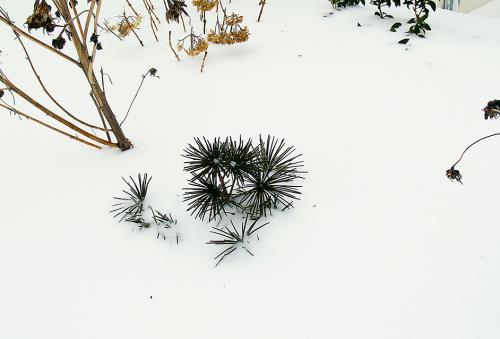Curse you, Polar Vortex! The winter of 2013-2014 was a record for plant damage in my garden. Frost heave appeared nearly everywhere, plants that typically overwintered didn’t, rhododendrons got beat up, rabbits chewed above-the-snow stems of blueberry shrubs to the ground, and some of my evergreens browned-out. My work was certainly cut out for me when spring arrived, but I could have avoided some of that damage to my plants if I'd done a little more preparation in late fall.
Harsh winter weather damages plants via freezing, hungry animals, dessication from winter sun and wind, and the salts you use to deice your walks. This is especially true of young plants. A plant’s odds of surviving the abuse of winter depends on its age and condition going into the season. If plants are well-established, well-nourished, well-hydrated, and free of insect damage and disease, they have a good chance of surviving. If you allow vulnerabilities, nature will take advantage of them.
But there’s also a new consideration: gardeners have been seeing plants overwinter in our landscapes which didn’t do so before. For me it’s been morning glory and sometimes basil seeds overwintering, along with cala lily bulbs and some others which typically have to be lifted in late fall . In the last ten years, we’ve also seen certain species of trees migrate northwards into zones in which they never overwintered before. Unfortunately, the Polar Vortex created a giant reboot for many of these plants and will do so again. So if you have tender plants and bulbs, lift them for the winter, even if they’ve survived previously.
How I’m protecting my plants from winter weather this year (and how you can too)
Wrap sensitive plants with burlap, especially those vulnerable to winter wind damage. This doesn’t mean that you literally wrap the plant like a Christmas gift. First, sink heavy duty stakes around the plant, safely outside of the root zone. Then wrap the burlap around the stakes, surrounding the plant. Burlap gets heavy when saturated with water, and it will definitely freeze. Having that weight and temperature in contact with your plant is not a good idea. Wrapping the burlap around the stakes allows 6 inches or more of air between the burlap and the plant, providing an excellent buffer against winter winds when storms roll in.
Mulch the root zones, but be selective about the type of mulch you use. Mulch is excellent for insulating soil, protecting it from frost heave, and regulating the freeze-thaw cycle. But mulches such as hardwood chips won’t do much in this area (although they'll make a nice warm winter home for mice and the like). If your plants can make it through late December without damage, cut the branches off your Christmas tree in early January and chop them into foot-long pieces. Place them around the base of your plants, about 6 inches high. If evergreen boughs are not in your future, use finished compost or straw piled 6 inches high, but keep it an inch or two from the stem or trunk. Keep in mind that winter mulch isn’t about aesthetics – it’s about protection. Besides, it’s frequently covered in snow.
Keep deicing chemicals safely away from sensitive plants. Deicers are largely salts, and salts dehydrate anything they touch. As the deicers melt, they get shoveled onto lawns and plants, and splashed on leaves. Be careful where you spread your deicers, and early in spring, if rain is in short supply, saturate the areas closest to the street, driveway, or walks with lots of water to dilute the salts. My strategy is to use no deicing salts at all, but I realize that’s not practical for everyone.
Protect sensitive plants from animals. Deer, rabbits, voles, mice, and all wildlife will eat just about anything if they’re hungry enough. When the ground is covered with snow, the only food available for them is what they find in easy reach above the snow line. Last winter, rabbits chewed my young blueberry shrubs to the ground when I wasn’t looking. How disappoined was I to find 6-inch tall shrubs when the snow melted? Now, the blueberry shrubs are safely ensconced in a raised bed, surrounded by 3-foot tall fencing. I’ve also surrounded sensitive plants in my yard likewise. If animals nibble on the bark of young trees and shrubs, disease may infect the plant in spring and at the very least, blooming will be discouraged. Not to mention the difficulties you'll have establishing that plant in your landscape, assuming the damage doesn’t kill the plant outright.
Plants cannot take up water from frozen ground, and send their roots deeper to find liquid water. If there is sufficient snowfall, hydration isn’t a problem. But during a dry, frigid winter, plants can become significantly dehydrated. This is what causes the browning of leaves in late winter and early spring. Water your plants deeply late in fall if you’ve had a particularly dry season.
If you’ve had a particularly harsh winter, be patient in early spring. If a plant looks sick or dead, there still may be life in the root system, so give it a little extra time to show its stuff. Bear in mind also that if soil has been frozen, it will take an extra 1-3 weeks to warm sufficiently to stimulate plant growth. And for God’s sake, don’t fertilize a plant when it’s in that condition, because you'll kill it.
This was written by Todd Heft, the head administrator for Big Blog of Gardening.com. This article was republished with permission, original here.




